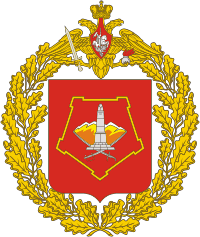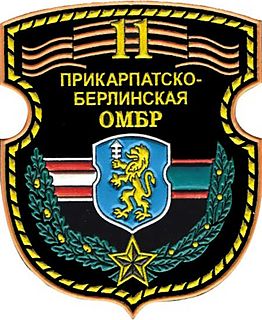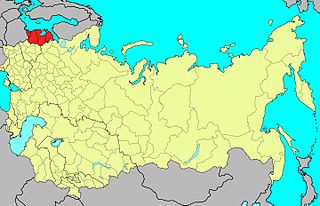
The 8th Guards Order of Lenin Combined Arms Army is an army of the Russian Ground Forces, headquartered in Novocherkassk, Rostov Oblast, within Russia′s Southern Military District, that was reinstated in 2017 as a successor to the 8th Guards Army of the Soviet Union's Red Army, which was formed during World War II and was disbanded in 1998 after being downsized into a corps.

The 1st Guards Tank Army is a tank army of the Russian Ground Forces.

The 2nd Tatsinskaya Guards Tank Corps was a Red Army tank corps that saw service during World War II on the Eastern Front. After the war it continued to serve with Soviet occupation forces in Central Europe. It was originally the 24th Tank Corps. The unit had approximately the same size and combat power as a Wehrmacht Panzer Division, and less than a British Armoured Division had during World War II.

The 201st Gatchina Twice Red Banner Motor Rifle Division was originally raised twice in World War II as part of the Soviet Union's Red Army and is now part of the Russian Ground Forces.

The 74th Guards Motor Rifle Brigade is a military formation of the Russian Ground Forces's 41st Army, part of Central Military District, stationed in Yurga, Kemerovo Oblast, Russia.

The Volga–Ural Military District was a military district of the Russian Ground Forces, formed on 1 September 2001 by the amalgamation of the Volga Military District and the Ural Military District. The headquarters of the Ural Military District, located at Yekaterinburg became the new headquarters of the merged district. In 2010 the District was merged with part of the Siberian Military District to form the new Central Military District.

The 10th Guards Uralsko-Lvovskaya Volunteer Tank Division, also known at the Ural-Lvov Tank Division, is a tank division of the Russian Ground Forces and part of the Moscow Military District's 20th Guards Army. The division traces its heritage back to 1943, during World War II. It is headquartered and based at Boguchar, 160 kilometres south of Voronezh, Voronezh Oblast.

The 90th Guards Tank Division was a division of the Soviet Army, and then of the Russian Ground Forces.
The 21st Guards Motor Rifle Division was a unit of the Russian Ground Forces, within the Far East Military District, formed from the Red Army 31st Guards Rifle Division, an infantry division of World War II which subsequently became a motor-rifle, a tank division and then back to a motor-rifle division. The division appears to have been disbanded, probably in 2009. At least one of its regiments became a separate motor rifle brigade.
The 20th Motor Rifle Division was a formation of the Russian Ground Forces, originally formed within the Soviet Red Army as the 3rd Mechanised Corps.

The 11th Guards Mechanized Brigade is a unit of the Armed Forces of Belarus based in Slonim. The 11th Guards Brigade traces its history back to the 1942 formation of the 6th Tank Corps of the Soviet Army during World War II.
The 78th Tank Division was a division of the Soviet Ground Forces, active from 1965 to the 1990s. It was originally established in 1949 as the 15th Tank Division, from the 78th Heavy Tank Self-Propelled Regiment. It gained the 78th designation in 1965. It was part of the 1st Army Corps from 1960, and was based at Ayaguz from 1970. Anatoly Kvashnin commanded the division from 1982 to 1987. In 1991, on the fall of the Soviet Union, the 78th Tank Division was serving at Ayaguz, Kazakh SSR, in the Turkestan Military District. In March 1992 it became part of the Kazakh Ground Forces, and soon after became the 78th Mechanized Division.
The 47th Motor Rifle Division was a motorized infantry division of the Soviet Army from 1969 to 1989. It was based in Konotop and became the 5198th Weapons and Equipment Storage Base in 1989. The 5198th combined with the 39th Guards Motor Rifle Division in 1991 to form the 5001st Guards Weapons and Equipment Storage Base.
The 134th Motor Rifle Division was a motorized infantry division of the Soviet Army. It existed between 1980 and 1989 and was based in Dushanbe.
The 93rd Motor Rifle Brigade was a motorized infantry brigade of the Russian Ground Forces. The brigade traces its origin back to the 135th Motor Rifle Division, formed in 1960 as a mobilization division in Luhansk. It became a regular division in 1968 and was transferred to Lesozavodsk.In 1989, it was renamed the 130th Machine Gun Artillery Division. It became the 93rd Separate Motor Rifle Brigade in 2009. It is now the 245th Weapons and Equipment Storage Base.
The 213th Motor Rifle Division was a motorized infantry division of the Soviet Army. The division was based in Totskoye and existed from 1968 to 1991. In 1991, the division merged with the 27th Guards Motor Rifle Division.
The 168th Motor Rifle Brigade was a Russian Ground Forces motorized infantry brigade from 1994 to 1998. It was based in Borzya and traces its lineage to the 150th Motor Rifle Division, activated in 1973. The division became a training unit three years later and was converted into a district training center in 1988. In 1994, the training center became the 168th Motor Rifle Brigade.
The 24th Tank Division was a tank division of the Soviet Union, formed twice. The division's first formation was formed in the spring of 1941 and fought in the Leningrad Strategic Defensive before being broken up into two smaller brigades. The division's second formation was originally formed in 1956 as the 24th Heavy Tank Division and became a regular tank division in 1957. It became a training division in 1960 and was redesignated the 54th District Training Center in 1987 before being disbanded in 1995.
The 1st Tank Division was a Division sized unit of the Red Army that existed from 1940 - 1942. Later re-formed and existed from 1945 - 2008 as a 2nd line ready division.














